Effect of Soil Tillage Practice on Photosynthesis, Grain Yield and Quality of Hybrid Winter Wheat
Abstract
1. Introduction
2. Materials and Methods
2.1. Field Trial Site and Experimental Treatments
- −
- Factor I—three soil tillage systems (T): (1) conventional (CT); (2) reduced (RT); and (3) no-tillage (NT), (Table 1);
- −
| Tillage (T) | Cultivation Measures |
|---|---|
| CT | Shallow ploughing was performed to a depth of 10–12 cm and harrowing, and in the first third of September, after the forecrop had been harvested, pre-sowing ploughing was performed to a depth of 20–22 cm. Shallow ploughing was performed with a 5-furrow and pre-sowing ploughing with a 3-furrow reversible plough. |
| RT | In post-harvest tillage, a disc harrow (2.5 m wide) was used to a depth of 13–15 cm, and before sowing, a tilling set (cultivator + string roller + harrow) 2.5 m wide was used. |
| NT | Herbicide treatment with glyphosate was performed at a dose of 4.0 dm3 ha−1 and wheat was sown directly into the stubble with a seeder with double disc coulters. |
| Cultivar (C) | Country Registering 1 | Grain Quality 2 | Maturity 3 | Plant Height 4 | Time of Sowing 5 |
|---|---|---|---|---|---|
| Hybery | FR, PL | B | ML | M/T | VE/O |
| Hyking | BE, CZ, FR | A | E | L/M | E/O |
| Hymalaya | DE | A | M | M | VE/O |
| Hypocamp | BE, FR | B | E | M | E/O |
| Hyvento | DE | A | M | M | O |
2.2. Soil and Weather Conditions
2.3. Physiological Measurements
2.3.1. Leaf Area Index
2.3.2. Relative Chlorophyll Content
2.3.3. Chlorophyll Fluorescence
2.3.4. Gas Exchange
2.4. Grain Yield and Plant Material
2.5. Analytical Methods
2.5.1. Quality Testing
2.5.2. Protein Extraction and Analysis
2.6. Statistical Analysis
3. Results and Discussion
3.1. Physiological Parameters
3.2. Grain Yield
3.3. Quality Parameters
Protein Composition and Characterisation
4. Conclusions
Author Contributions
Funding
Institutional Review Board Statement
Informed Consent Statement
Data Availability Statement
Conflicts of Interest
References
- FAOSTAT. Available online: http://www.fao.org/faostat/en/#data/QC (accessed on 12 April 2020).
- Shewry, P.R. Wheat. J. Exp. Bot. 2009, 60, 1537–1553. [Google Scholar] [CrossRef]
- Glenn, K.C.; Alsop, B.; Bell, E.; Goley, M.; Jenkinson, J.; Liu, B.; Martin, C.; Parrott, W.; Souder, C.; Sparks, O.; et al. Bringing New Plant Varieties to Market: Plant Breeding and Selectin Practices Advance Beneficial Characteristics while Minimizing Unintended Changes. Crop. Sci. 2017, 57, 2906–2921. [Google Scholar] [CrossRef]
- Liu, G.; Zhao, Y.; Mirdita, V.; Reif, J.C. Efficient strategies to assess yield stability in winter wheat. Theor. Appl. Genet. 2017, 130, 1587–1599. [Google Scholar] [CrossRef] [PubMed]
- Whitford, R.; Fleury, D.; Reif, J.C.; Garcia, M.; Okada, T.; Korzun, V.; Langridge, P. Hybrid breeding in wheat: Technologies to improve hybrid wheat seed production. J. Exp. Bot. 2013, 64, 5411–5428. [Google Scholar] [CrossRef] [PubMed]
- Reynolds, M.P.; Rajaram, S.; McNab, A. Chapter 2. Hybrid wheat: Advances and challenges. In Increasing Yield. Potential in Wheat: Breaking the Barriers; Proceedings of a Workshop Held in Ciudad Obregon, Sonora; CIMMYT: Mexico City, Mexico, 1996. [Google Scholar]
- Milan, M.; Fogliatto, S.; Blandino, M.; Vidotto, F. Are wheat hybrids more affected by weed competition than conventional cultivars? Agronomy 2020, 10, 526. [Google Scholar] [CrossRef]
- Basnet, B.R.; Crossa, J.; Dreisigacker, S.; Pérez-Rodríguez, P.; Manes, Y.; Singh, R.P.; Rosyara, U.R.; Camarillo-Castillo, F.M.; Murua, M. Hybrid wheat prediction using genomic, pedigree, and environmental covariables interaction models. Plant Genome 2019, 12, 180051. [Google Scholar] [CrossRef] [PubMed]
- Prey, L.; Kipp, S.; Hu, Y.; Schmidhalter, U. Nitrogen Use Efficiency and carbon traits of high-yielding european hybrid vs. line winter wheat cultivars: Potentials and limitations. Front. Plant Sci. 2019, 9, 1988. [Google Scholar] [CrossRef] [PubMed]
- Muqaddasi, Q.H.; Reif, J.C.; Röder, M.S.; Basnet, B.R.; Dreisigacker, S. Genetic mapping reveals large-effect QTL for anther extrusion in CIMMYT spring wheat. Agronomy 2019, 9, 407. [Google Scholar] [CrossRef]
- ASAE. Terminology and Definitions for Soil Tillage and Soil-Tool Relationships; American Society of Agricultural and Biological Engineers: St. Joseph, MI, USA, 2016. [Google Scholar]
- Stajnko, D.; Lakota, M.; Vucajnk, F.; Bernik, R. The effect of dierent tillage systems on fuel saving and reduction of CO2 emmission in production of silage corn in Eastern Slovenia. Pol. J. Environ. Stud. 2009, 18, 709–714. [Google Scholar]
- Jaskulska, I.; Jaskulski, D. Strip-Till One-Pass Technology in Central and Eastern Europe: A MZURI Pro-Til Hybrid Machine Case Study. Agronomy 2020, 10, 925. [Google Scholar] [CrossRef]
- Busari, M.A.; Kukal, S.S.; Kaur, A.; Bhatt, R.; Dulazi, A.A. Conservation tillage impacts on soil, crop and the environment. Int. Soil Water Conserv. Res. 2015, 3, 119–129. [Google Scholar] [CrossRef]
- Blanco-Canqui, H.; Mikha, M.M.; Benjamin, J.G.; Stone, L.R.; Schlegel, A.J.; Lyon, D.J.; Vigil, M.F.; Stahlman, P.W. Regional study of no-till impacts on near-surface aggregate properties that influence soil erodibility. Soil Sci. Soc. Am. J. 2009, 73, 1361–1368. [Google Scholar] [CrossRef]
- Soane, B.D.; Ball, B.C.; Arvidsson, J.; Basch, G.; Moreno, F.; Roger-Estrade, J. No-till in northern, western and south-western Europe: A review of problems and opportunities for crop production and the environment. Soil Tillage Res. 2012, 118, 66–87. [Google Scholar] [CrossRef]
- Hou, X.; Li, R.; Jia, Z.; Han, Q. Rotational tillage improves photosynthesis of winter wheat during reproductive growth stages in a semiarid region. Agron. J. 2013, 105, 215–221. [Google Scholar] [CrossRef]
- Carter, M.R. A review of conservation tillage strategies for humid temperate regions. Soil Tillage Res. 1994, 31, 289–301. [Google Scholar] [CrossRef]
- Horvat, D.; Drezner, G.; Sudar, R.; Šimić, G.; Dvojković, K.; Španić, V.; Magdić, D. Distribution of wheat protein components under different genetic backgrounds and environments. Turk. J. Field Crops. 2015, 20, 150–154. [Google Scholar] [CrossRef][Green Version]
- Peigné, J.; Messmer, M.; Aveline, A.; Berner, A.; Mäder, P.; Carcea, M.; Narducci, V.; Samson, M.-F.; Thomsen, I.K.; Celette, F.; et al. Wheat yield and quality as influenced by reduced tillage in organic farming. Org. Agric. 2014, 4, 1–13. [Google Scholar] [CrossRef]
- Jaskulska, I.; Jaskulski, D.; Gałęzewski, L.; Knapowski, T.; Kozera, W.; Wacławowicz, R. Mineral composition and baking value of the winter wheat grain under varied environmental and agronomic conditions. J. Chem. 2018, 2018. [Google Scholar] [CrossRef]
- Taner, A.; Arisoy, R.Z.; Kaya, Y.; Gultekin, I.; Partigoc, F. The effects of various tillage systems on grain yield, quality parameters and energy indices in winter wheat production under the rainfed conditions. Fresenius Environ. Bull. 2015, 24, 1463–1473. [Google Scholar]
- De Vita, P.; Di Paolo, E.; Fecondo, G.; Di Fonzo, N.; Pisante, M. No-tillage and conventional tillage effects on durum wheat yield, grain quality and soil moisture content in southern Italy. Soil Till. Res. 2007, 92, 69–78. [Google Scholar] [CrossRef]
- Šip, V.; Vavera, R.; Chrpova, J.; Kusa, P. Winter wheat yield and quality related to tillage practice. input level and environmental condition. Soil Tillage Res. 2013, 132, 77–85. [Google Scholar] [CrossRef]
- Hofmeijer, J.A.M.; Krauss, M.; Berner, A.; Peigné, J.; Mäder, P.; Armengot, L. Effects of reduced tillage on weed pressure, nitrogen availability and winter wheat yields under organic management. Agronomy 2019, 9, 180. [Google Scholar] [CrossRef]
- CCA. Common Catalogue of Varieties of Agricultural Plant Species. Official Journal of EU/C4. 2020. Available online: https://ec.europa.eu/food/sites/food/files/plant/docs/plant-variety-catalogues_agricultural-plant-species.pdf (accessed on 26 March 2021).
- Available online: https://www.asur-plantbreeding.com (accessed on 10 March 2021).
- Meier, U. Growth Stages of Mono-and Dicotyledonous Plants; BBCH Monograph: Julius Kühn-Institut: Quedlinburg, Germany, 2018; p. 204. [Google Scholar] [CrossRef]
- IOR-PIB. Recommendations Protection of Plants 2012; Agricultural Plants, 2; Institute of Plant Protection-National Research Institute: Poznan, Poland, 2013; p. 305. [Google Scholar]
- USS Working Group WRB. International soil classification system for naming soils and creating legends for soil maps. In Word Reference Base for Soil Resources 2014, Update 2015; Word Soil Resources Reports No. 106; FAO: Rome, Italy, 2015; pp. 172–173. [Google Scholar]
- Skowera, B. Changes of hydrothermal conditions in the Polish area (1971–2010). Fragm. Agron. 2014, 31, 74–87. (In Polish) [Google Scholar]
- Maxwell, K.; Johnson, G.N. Chlorophyll fluorescence—A practical guide. J. Exp. Bot. 2000, 51, 659–668. [Google Scholar] [CrossRef] [PubMed]
- AACC. American Association of Cereal Chemists (AACC) International Approved Methods of Analysis, 11th ed.; AACC: St. Paul, MN, USA, 2009. [Google Scholar]
- ICC. International Association for Cereal Science and Technology (ICC) Standard Methods; ICC: Vienna, Austria, 2005. [Google Scholar]
- Wieser, H.; Antes, S.; Seilmeier, W. Quantitative determination of gluten protein types in wheat flour by reversed-phase high-performance liquid chromatography. Cereal Chem. 1998, 75, 544–650. [Google Scholar] [CrossRef]
- Wojtkowiak, K.; Stępień, A. Nutritive value of spelt (Triticum aestivum spp. spelta L.) as influenced by the foliar application of copper, zinc and manganese. Zemdirb. Agric. 2015, 4, 389–396. [Google Scholar] [CrossRef][Green Version]
- Konopka, I.; Tańska, M.; Pszczółkowska, A.; Fordoński, G.; Kozirok, W.; Olszewski, J. The effect of water stress on wheat kernel size, color and protein composition. Pol. J. Nat. Sci. 2007, 2, 157–171. [Google Scholar] [CrossRef]
- Banerjee, V.; Krishnan, P.; Das, B.; Verma, A.P.S.; Varghese, E. Crop status index as an indicator of wheat crop growth conditio under abiotic stress situations. Field Crops Res. 2015, 181, 16–31. [Google Scholar] [CrossRef]
- Kulig, B.; Lepiarczyk, A.; Oleksy, A.; Kołodziejczyk, M. The effect of tillage system and forecrop on the yield and values of LAI and SPAD indices of spring wheat. Eur. J. Agron. 2010, 33, 43–51. [Google Scholar] [CrossRef]
- Liu, J.; Fan, Y.; Ma, Y.; Li, Q. Response of photosynthetic active radiation interception, dry matter accumulation, and grain yield to tillage in two winter wheat genotypes. Arch. Agron. Soil Sci. 2020, 66, 1103–1114. [Google Scholar] [CrossRef]
- Liu, K.; Wiatrak, P. Corn production response to tillage and nitrogen application in dry-land environment. Soil Tillage Res. 2012, 124, 138–143. [Google Scholar] [CrossRef]
- Kalaji, H.M.; Jajoo, A.; Oukarroum, A.; Brestic, M.; Zivcak, M.; Samborska, I.A.; Cetner, M.D.; Łukasik, I.; Goltsev, V.; Ladle, R.J. Chlorophyll a fluorescence as a tool to monitor physiological status of plants under abiotic stress conditions. Acta Physiol. Plant. 2016, 38, 102. [Google Scholar] [CrossRef]
- Badr, A.; Brüggemann, W. Comparative analysis of drought stress response of maize genotypes using chlorophyll fluorescence measurements and leaf relative water content. Photosynthetica 2020, 58, 638–645. [Google Scholar] [CrossRef]
- Stępień-Warda, A. Effect of soil cultivation system on the efficiency of the photosynthetic apparatus in maize leaves (Zea mays L.). Pol. J. Agron. 2020, 43, 57–62. [Google Scholar] [CrossRef]
- Savvides, A.M.; Fotopoulos, V. Two inexpensive and non-destructive techniques to correct for smaller-than-gasket leaf area in gas exchange measurements. Front. Plant Sci. 2018, 9, 548. [Google Scholar] [CrossRef]
- Skider, S.; Qiao, Y.; Baodi, D.; Shi, C.; Liu, M. Effect of water stress on leaf level gas exchange capacity and water-use efficiency of wheat cultivars. Indian J. Plant Physiol. 2016, 21, 300–305. [Google Scholar] [CrossRef]
- Lamptey, S.; Li, L.; Xie, J.; Coulter, J.A. Tillage system affects soil water and photosynthesis of plastic-mulched maize on the semiarid Loess Plateau of China. Soil Tillage Res. 2020, 196, 104479. [Google Scholar] [CrossRef]
- Wu, X.L.; Bao, W.K. Leaf growth, gas exchange and chlorophyll fluorescence parameters in response to different water deficits in wheat cultivars. Plant Prod. Sci. 2011, 14, 254–259. [Google Scholar] [CrossRef]
- Cayón, M.G.; El-Sharkawy, M.A.; Cadavid, L.F. Leaf gas exchange of cassava as affected by quality of planting material and water stress. Photosynthetica 1997, 34, 409–418. [Google Scholar] [CrossRef]
- Hassan, I.A. Effects of water stress and high temperature on gas exchange and chlorophyll fluorescence in Triticum aestivum L. Photosynthetica 2006, 44, 312–315. [Google Scholar] [CrossRef]
- Gao, F.; Jia, Z.K.; Lu, W.T.; Han, Q.F.; Yao, B.P.; Hou, X.Q. Effects of different straw returning treatments on soil water, maize growth and photosynthetic characteristics in the semi-arid area of Southern Ningxia. Acta Ecol. Sin. 2011, 31, 777–783. [Google Scholar]
- Małecka, I.; Blecharczyk, A.; Sawinska, Z.; Dobrzeniecki, T. The effect of various long-term tillage systems on soil properties and spring barley yield. Turk. J. Agric. For. 2012, 36, 217–226. [Google Scholar] [CrossRef]
- Cociu, A.I.; Alionte, E. Effect of different tillage systems on grain yield and its quality of winter wheat, maize and soybean under different weather conditions. Rom. Agric. Res. 2017, 34, 59–67. [Google Scholar]
- Woźniak, A.; Rachoń, L. Effect of tillage systems on the yield and quality of winter wheat grain and soil properties. Agriculture 2020, 10, 405. [Google Scholar] [CrossRef]
- Piao, L.; Li, M.; Xiao, J.; Gu, W.; Zhan, M.; Cao, C.; Zhao, M.; Li, C. Effects of soil tillage and canopy optimization on grain yield, root growth, and water use efficiency of rainfed maize in Northeast China. Agronomy 2019, 9, 336. [Google Scholar] [CrossRef]
- Rieger, S.; Richner, W.; Streit, B.; Frossard, E.; Liedgens, M. Growth, yield, and yield components of winter wheat and the effects of tillage intensity, preceding crops, and N fertilisation. Eur. J. Agron. 2008, 28, 405–411. [Google Scholar] [CrossRef]
- Jaskulska, I.; Jaskulski, D.; Różniak, M.; Radziemska, M.; Gałęzewski, L. Zonal tillage as innovative element of the technology of growing winter wheat: A fiel experiment under low rainfall conditions. Agriculture 2020, 10, 105. [Google Scholar] [CrossRef]
- Fernández, F.G.; Sorensenb, B.A.; Villamil, M.B. A comparison of soil properties after five years of no-till and strip-till. Agron. J. 2015, 107, 1339–1346. [Google Scholar] [CrossRef]
- Giannitsopoulos, M.L.; Burgess, P.J.; Rickson, R.J. Effects of conservation tillage systems on soil physical changes and crop yields in a wheat-oilseed rape rotation. J. Soil Water Conserv. 2019, 74, 247–258. [Google Scholar] [CrossRef]
- Woźniak, A. Chemical properties and enzyme activity of soil as a effcted by tillage system and previous crop. Agriculture 2019, 9, 262. [Google Scholar] [CrossRef]
- Lal, R. Soil quality impacts of residue removal for bioethanol production. Soil Tillage Res. 2009, 102, 233–241. [Google Scholar] [CrossRef]
- Woźniak, A.; Gos, M. Yield and quality of spring wheat and soil properties as affected by tillage system. Plant Soil Environ. 2014, 60, 141–145. [Google Scholar] [CrossRef]
- Liniņa, A.; Ruza, A. Impact of agroecological conditions on the Hagberg falling number of winter wheat grain. Res. Rural Dev. 2015, 1, 19–26. [Google Scholar]
- Ma, D.; Guo, T.; Wang, Z.; Wang, C.; Zhu, Y.; Wang, Y. Influence of nitrogen fertilizer application rate on winter wheat (Triticum aestivum L.) flour quality and Chinese noodle quality. J. Sci. Food Agric. 2009, 89, 1213–1220. [Google Scholar] [CrossRef]
- García-Molina, D.M.; Barro, F. Characterization of changes in gluten proteins in low-gliadin transgenic wheat lines in response to application of different nitrogen regimes. Front. Plant Sci. 2017, 8, 257. [Google Scholar] [CrossRef]
- Šekularac, A.; Torbica, A.; Živančev, D.; Tomić, J.; Knežević, D. The influence of wheat genotype and environmental factors on gluten index and the possibility of its use as bread quality predictor. Genetika 2018, 50, 85–93. [Google Scholar] [CrossRef]
- Bueno, M.M.; Thys, R.C.S.; Rodrigues, R.C. Microbial enzymes as substitutes of chemical additives in baking wheat flour-part I: Individual effects of nine enzymes on flour dough rheology. Food Bioprocess. Tech. 2016, 9, 2012–2023. [Google Scholar] [CrossRef]
- Ćurić, D.; Karlović, D.; Tušak, D.; Petrović, B.; Đugum, J. Gluten as a standard of wheat flour quality. Food Technol. Biotechnol. 2001, 4, 353–361. [Google Scholar]
- Pagnani, G.; Galieni, A.; D’Egidio, S.; Visioli, D.; Stagnari, F.; Pisante, P. Effect of soil tillage and crop sequence on grain yield and quality of durum wheat in Mediterranean areas. Agronomy 2019, 9, 488. [Google Scholar] [CrossRef]
- Ramírez-Wong, B.; Rodríguez-Félix, F.; Torres-Chávez, P.; Medina-Rodríguez, M.; Matus-Barba, E.; Ledesma-Osuna, A. Effects of Nitrogen and Irrigation on Gluten Protein Composition and their Relationship to “Yellow Berry” Disorder in Wheat (Triticum aestivum). Pak. J. Bot. 2014, 46, 1797–1804. Available online: www.pakbs.org/pjbot/PDFs/46(5)/34.pdf (accessed on 26 March 2021).
- Buczek, J.; Jarecki, W.; Bobrecka-Jamro, D. The response of population and hybrid wheat to selected agro-environmental factors. Plant Soil Environ. 2016, 62, 67–73. [Google Scholar] [CrossRef]
- Fuertes-Mendizábal, T.; Aizpurua, A.; González-Moro, M.B.; Estavillo, J.M. Improving wheat breadmaking quality by splitting the N fertilizer rate. Eur. J. Agron. 2010, 33, 52–61. [Google Scholar] [CrossRef]

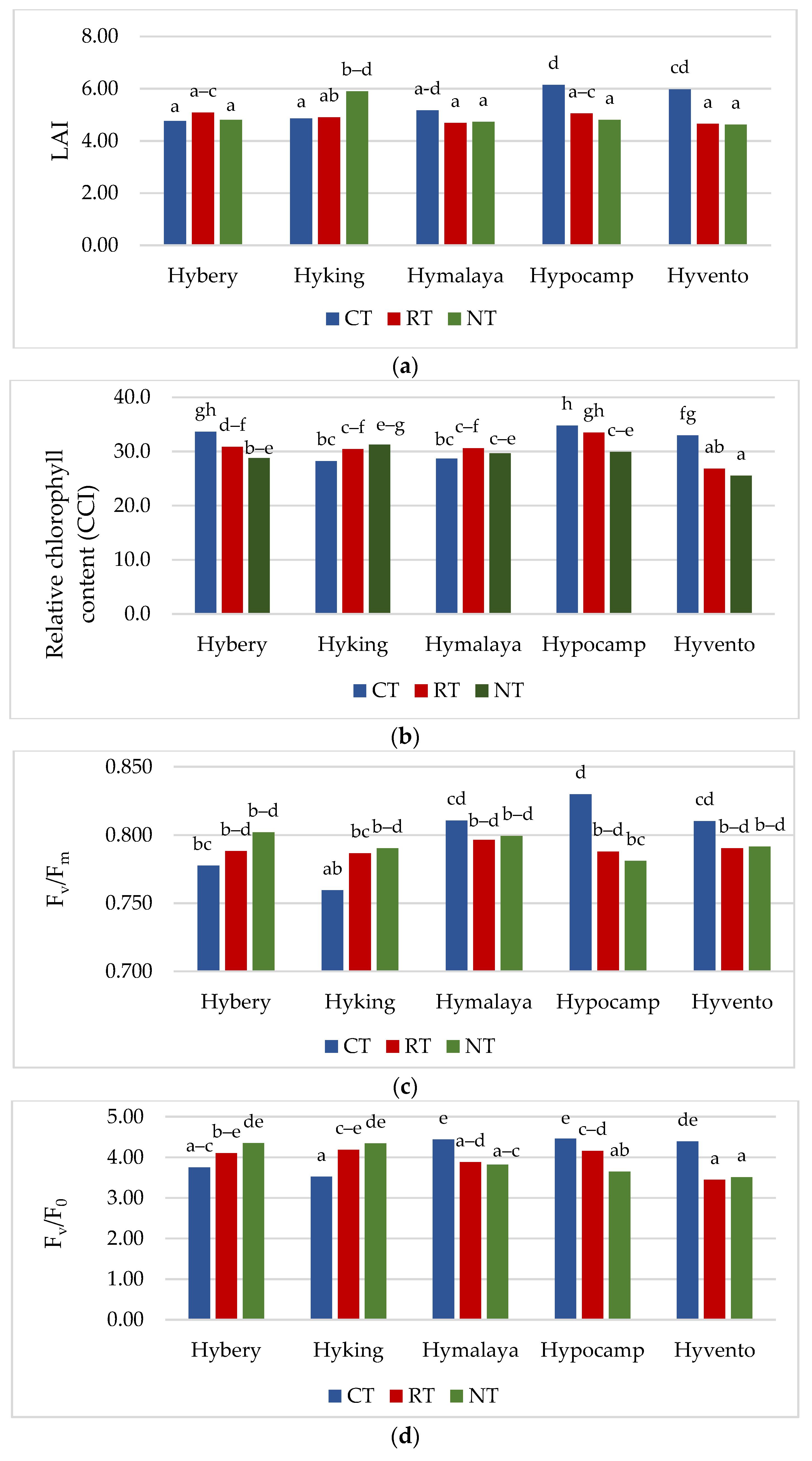
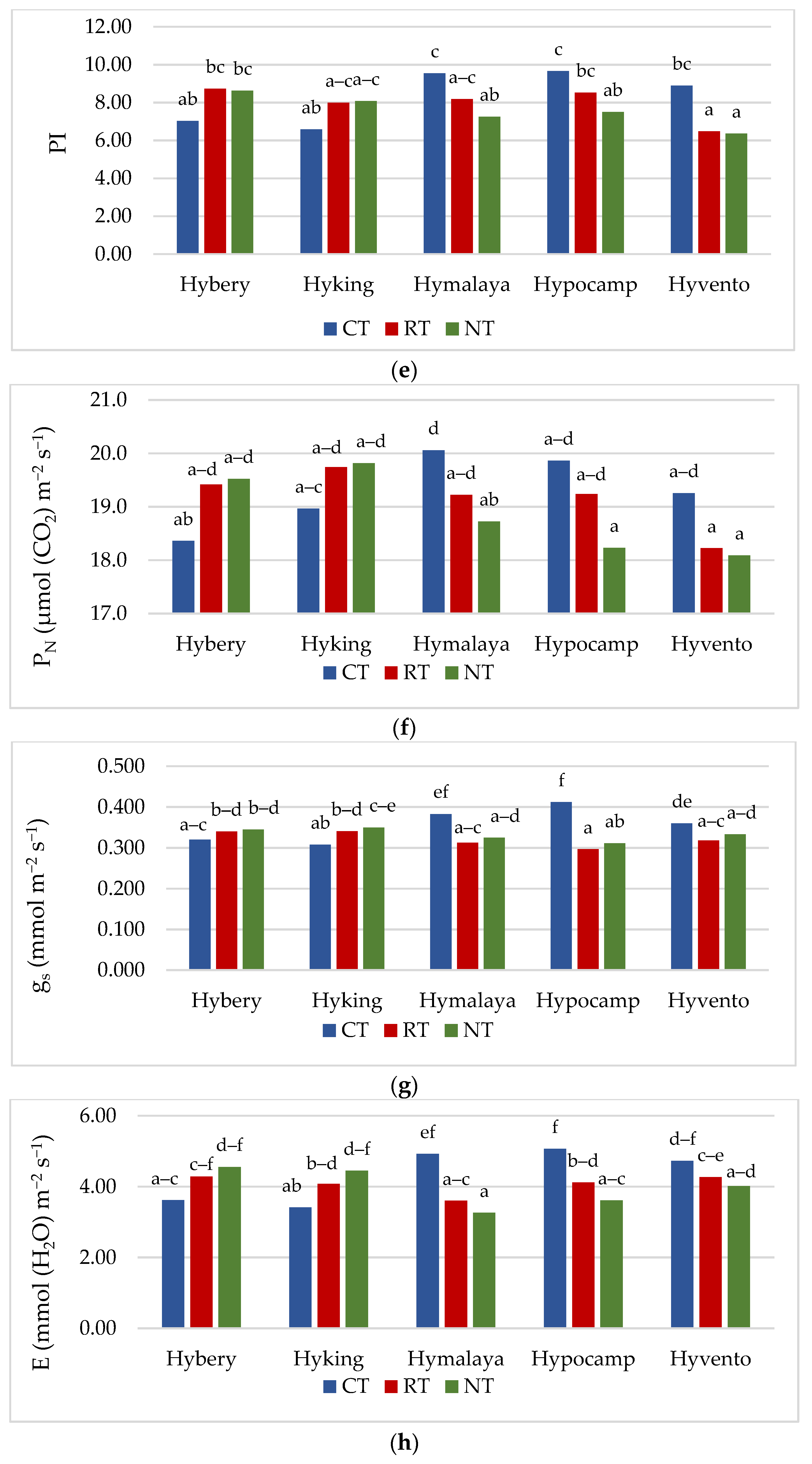
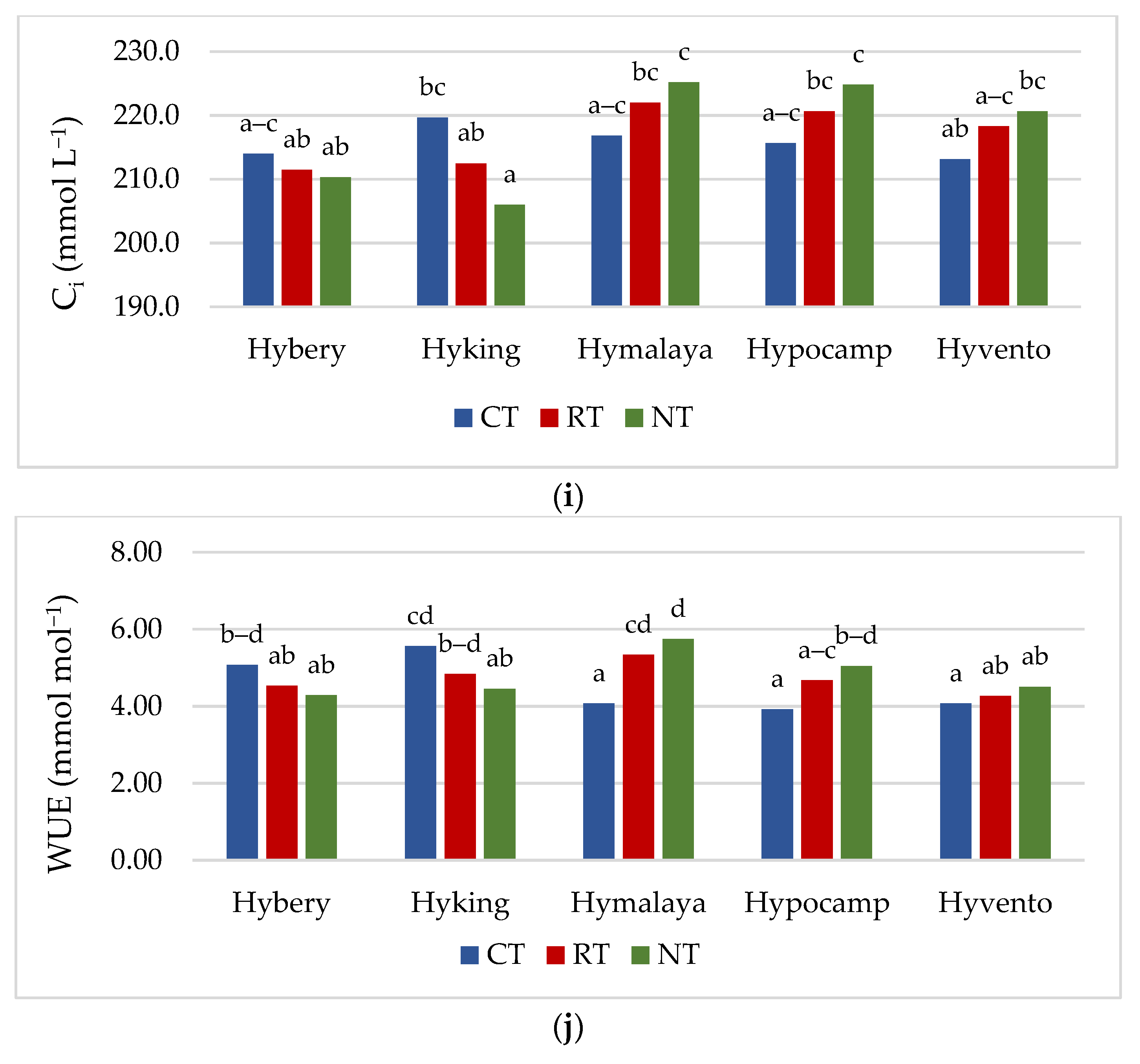

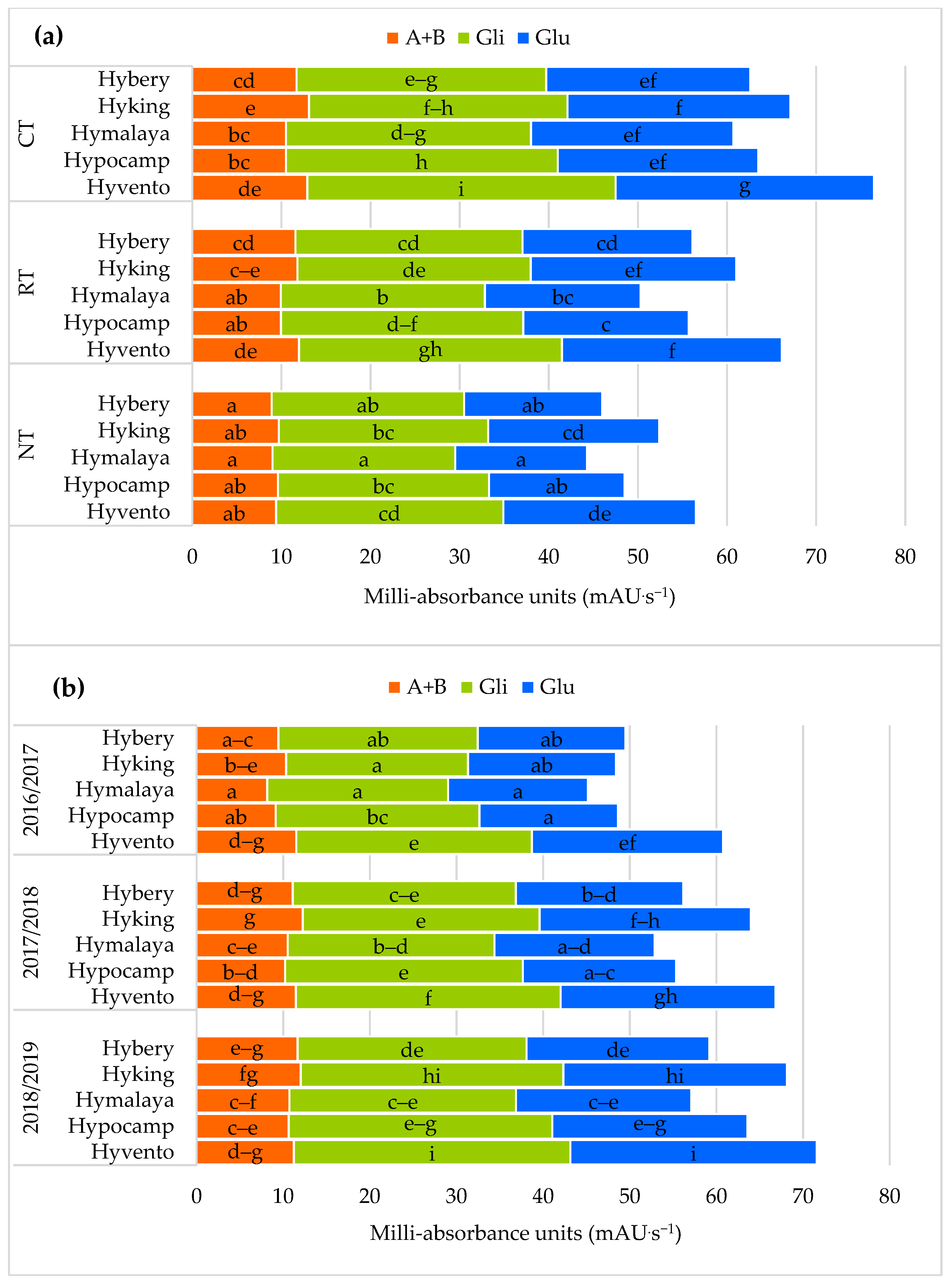
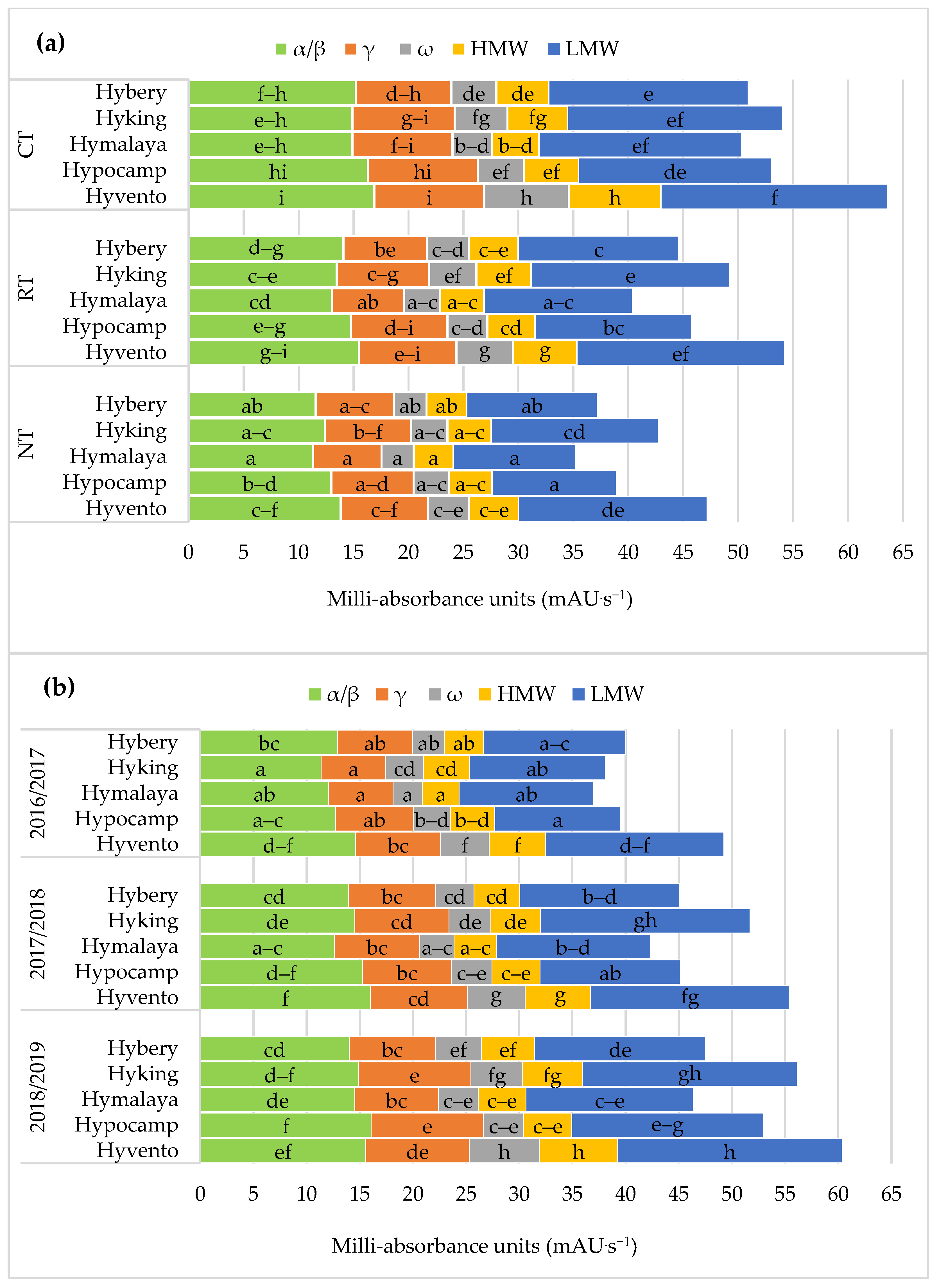
| Year | Month (K) | K | Sum (IV–VII) | ||||
|---|---|---|---|---|---|---|---|
| April | May | June | July | p | t | ||
| 2016/2017 | 3.0 (vh) | 2.5 (h) | 1.1 (rd) | 1.0 (d) | 1.9 (rh) | 278.6 | 1478 |
| 2017/2018 | 0.5 (vd) | 1.6 (o) | 0.9 (d) | 2.0 (rh) | 1.3 (rd) | 243.7 | 1928 |
| 2018/2019 | 1.3 (rd) | 1.7 (rh) | 0.4 (ed) | 0.7 (vd) | 1.0 (rd) | 169.0 | 1770 |
| 1956–2015 | 1.7 (rh) | 1.8 (rh) | 1.6 (o) | 1.5 (o) | 1.4 (o) | 283.6 | 1698 |
| Factor | Grain Yield (t ha−1) | LAI | Relative Chlorophyll Content (CCI) | Chlorophyll Fluorescence | Gas Exchange | |||||||
|---|---|---|---|---|---|---|---|---|---|---|---|---|
| Tillage (T) | Cultivar (C) | Fv/Fm | Fv/F0 | PI | PN (μmol CO2 m−2 s−1) | gs (mol H2O m−2 s−1) | E (mmol H2O m−2 s−1) | Ci (mmol L−1) | WUE (mmol∙mol−1) | |||
| CT | 9.13 b | 5.38 b | 31.7 c | 0.797 b | 4.11 b | 5.38 b | 19.3 b | 0.357 b | 4.35 b | 215.9 a | 4.54 a | |
| RT | 8.74 a | 4.88 a | 30.4 b | 0.790 a | 3.96 a | 4.88 a | 19.1 b | 0.322 a | 4.07 a | 217.0 a | 4.73 b | |
| NT | 8.82 a | 4.97 a | 29.0 a | 0.793 a | 3.93 a | 4.97 a | 18.9 a | 0.333 a | 3.98 a | 217.4 a | 4.81 b | |
| Hybery | 8.83 ab | 4.88 a | 31.1 c | 0.789 c | 4.07 b | 4.88 a | 19.1 b | 0.335 a | 4.16 ab | 211.9 a | 4.63 ab | |
| Hyking | 9.12 bc | 5.22 ab | 30.0 bc | 0.779 a | 4.02 b | 5.22 ab | 19.5 b | 0.333 a | 3.98 a | 212.7 a | 4.95 b | |
| Hymalaya | 8.62 a | 4.86 a | 29.6 b | 0.802 c | 4.05 b | 4.86 a | 19.3 b | 0.340 a | 3.93 a | 221.4 b | 5.05 b | |
| Hypocamp | 9.33 c | 5.33 b | 32.8 d | 0.800 c | 4.09 b | 5.33 b | 19.1 b | 0.340 a | 4.27 ab | 220.4 b | 4.55 ab | |
| Hyvento | 8.58 a | 5.09 a | 28.4 a | 0.797 bc | 3.78 a | 5.09 a | 18.5 a | 0.337 a | 4.34 b | 217.4 ab | 4.28 a | |
| Year (Y) | ||||||||||||
| 2016/2017 | 9.06 b | 5.23 b | 31.2 b | 0.791 ab | 4.08 b | 8.07 ab | 19.3 ab | 0.343 b | 4.27 b | 217.8 b | 4.54 a | |
| 2017/2018 | 9.67 c | 5.65 c | 33.1 c | 0.804 b | 4.18 c | 8.15 b | 19.6 b | 0.348 b | 4.24 b | 212.8 a | 4.64 ab | |
| 2018/2019 | 7.96 a | 4.36 a | 26.9 a | 0.783 a | 3.75 a | 7.70 a | 18.5 a | 0.319 a | 3.88 a | 219.7 b | 4.79 b | |
| Mean | 8.90 | 5.08 | 30.4 | 0.793 | 4.00 | 7.97 | 19.1 | 0.337 | 4.13 | 216.8 | 4.69 | |
| T | *** | * | *** | *** | *** | *** | *** | *** | *** | ns | ** | |
| C | *** | *** | *** | *** | *** | * | * | ns | * | * | *** | |
| Y | *** | *** | *** | ** | *** | * | * | * | *** | ** | ** | |
| T × C | *** | *** | *** | *** | *** | *** | *** | *** | *** | *** | *** | |
| T × Y | *** | * | *** | *** | * | ** | * | * | *** | *** | *** | |
| C × Y | *** | ns | *** | *** | *** | ** | *** | *** | *** | * | *** | |
| T × C × Y | ** | ns | *** | *** | *** | *** | *** | *** | *** | *** | *** | |
| Factor | Crude Protein (g kg−1) | Wet Gluten (%) | Zeleny Test (mL) | Falling Number (s) | Total Ash (%) | Gluten Index (%) | |
|---|---|---|---|---|---|---|---|
| Tillage (T) | Cultivar (C) | ||||||
| CT | 130 b | 27.6 b | 46.1 c | 315 b | 0.48 a | 97 c | |
| RT | 127 b | 26.2 b | 38.8 b | 293 a | 0.51 b | 95 b | |
| NT | 117 a | 22.6 a | 34.8 a | 300 a | 0.54 b | 91 a | |
| Hybery | 123 a | 25.4 b | 37.3 a | 288 b | 0.48 a | 97 d | |
| Hyking | 126 b | 26.0 b | 43.2 b | 319 c | 0.57 c | 94 bc | |
| Hymalaya | 121 a | 24.0 a | 35.5 a | 335 d | 0.51 ab | 96 cd | |
| Hypocamp | 123 a | 24.1 a | 37.3 a | 252 a | 0.47 a | 92 ab | |
| Hyvento | 132 c | 27.9 c | 46.0 c | 318 c | 0.53 b | 92 a | |
| Year (Y) | |||||||
| 2016/2017 | 117 a | 23.7 a | 35.5 a | 286 a | 0.50 a | 94 a | |
| 2017/2018 | 125 b | 25.5 b | 40.6 c | 289 a | 0.50 a | 95 a | |
| 2018/2019 | 132 c | 27.3 c | 43.5 b | 333 b | 0.54 a | 93 a | |
| Mean | 125 | 25.3 | 39.9 | 302 | 0.51 | 94 | |
| T | *** | *** | *** | *** | *** | *** | |
| C | *** | *** | *** | *** | *** | *** | |
| Y | *** | *** | *** | *** | ns | ns | |
| T × C | ** | ns | ns | ns | *** | *** | |
| T × Y | ** | ns | * | ns | ns | ns | |
| C × Y | *** | ** | *** | *** | *** | ns | |
| T × C × Y | ns | ns | ns | ns | ns | ns | |
| Factor | Albumins Globulins | Gliadins (Gli) | Glutenins (Glu) | Ratio | |||||||
|---|---|---|---|---|---|---|---|---|---|---|---|
| α/β | γ | ω | Ʃ Gli 1 | H 3 | L 4 | Ʃ Glu 2 | |||||
| Tillage (T) | Cultivar (C) | mAU·s−1 | H/L 5 | Gli/Glu 6 | |||||||
| CT | 11.7 b | 15.6 b | 9.4 c | 4.9 c | 29.9 c | 5.6 c | 18.8 b | 24.4 c | 0.30 a | 1.23 a | |
| RT | 11.0 b | 14.2 b | 8.1 b | 4.0 b | 26.3 b | 4.7 b | 15.8 b | 20.6 b | 0.31 a | 1.30 a | |
| NT | 9.30 a | 12.4 a | 7.3 a | 3.2 a | 23.0 a | 4.0 a | 13.3 a | 17.3 a | 0.31 a | 1.36 a | |
| Hybery | 10.7 b | 13.6 a | 7.8 a | 3.6 b | 25.0 b | 4.3 b | 14.8 a | 19.2 a | 0.30 ab | 1.33 b | |
| Hyking | 11.5 c | 13.6 a | 8.5 b | 4.1 c | 26.2 c | 4.8 c | 17.6 b | 22.4 b | 0.28 a | 1.18 a | |
| Hymalaya | 9.8 a | 13.1 a | 7.3 a | 3.3 a | 23.6 a | 4.0 a | 14.3 a | 18.3 a | 0.29 a | 1.31 b | |
| Hypocamp | 10.0 a | 14.7 b | 8.8 b | 3.7 b | 27.1 c | 4.4 b | 14.3 a | 18.8 a | 0.33 c | 1.48 c | |
| Hyvento | 11.4 c | 15.4 c | 8.9 b | 5.5 d | 29.9 d | 6.3 d | 18.9 c | 25.1 c | 0.33 bc | 1.19 a | |
| Year (Y) | |||||||||||
| 2016/2017 | 9.7 a | 12.7 a | 6.9 a | 3.5 a | 23.1 a | 4.2 a | 13.5 a | 17.7 a | 0.31 a | 1.33 a | |
| 2017/2018 | 11.1 b | 14.5 b | 8.5 b | 4.0 b | 27.0 b | 4.7 b | 16.2 b | 20.9 b | 0.30 a | 1.32 a | |
| 2018/2019 | 11.3 b | 15.0 c | 9.4 b | 4.7 c | 29.0 c | 5.4 c | 18.2 b | 23.6 c | 0.30 a | 1.25 a | |
| Mean | 10.7 | 14.1 | 8.3 | 4.1 | 26.4 | 4.7 | 16.0 | 20.7 | 0.30 | 1.30 | |
| T | *** | *** | *** | *** | *** | *** | *** | *** | ns | ns | |
| C | *** | *** | *** | *** | *** | *** | *** | *** | *** | *** | |
| Y | *** | *** | *** | *** | *** | *** | *** | *** | ns | ns | |
| T × C | *** | * | ** | *** | ** | *** | ** | * | *** | * | |
| T × Y | ** | ns | ns | ns | *** | * | ns | * | ns | ns | |
| C × Y | *** | *** | *** | *** | *** | *** | *** | *** | *** | * | |
| T × C × Y | ns | ns | ns | ns | ns | ns | * | ns | ns | * | |
Publisher’s Note: MDPI stays neutral with regard to jurisdictional claims in published maps and institutional affiliations. |
© 2021 by the authors. Licensee MDPI, Basel, Switzerland. This article is an open access article distributed under the terms and conditions of the Creative Commons Attribution (CC BY) license (https://creativecommons.org/licenses/by/4.0/).
Share and Cite
Buczek, J.; Migut, D.; Jańczak-Pieniążek, M. Effect of Soil Tillage Practice on Photosynthesis, Grain Yield and Quality of Hybrid Winter Wheat. Agriculture 2021, 11, 479. https://doi.org/10.3390/agriculture11060479
Buczek J, Migut D, Jańczak-Pieniążek M. Effect of Soil Tillage Practice on Photosynthesis, Grain Yield and Quality of Hybrid Winter Wheat. Agriculture. 2021; 11(6):479. https://doi.org/10.3390/agriculture11060479
Chicago/Turabian StyleBuczek, Jan, Dagmara Migut, and Marta Jańczak-Pieniążek. 2021. "Effect of Soil Tillage Practice on Photosynthesis, Grain Yield and Quality of Hybrid Winter Wheat" Agriculture 11, no. 6: 479. https://doi.org/10.3390/agriculture11060479
APA StyleBuczek, J., Migut, D., & Jańczak-Pieniążek, M. (2021). Effect of Soil Tillage Practice on Photosynthesis, Grain Yield and Quality of Hybrid Winter Wheat. Agriculture, 11(6), 479. https://doi.org/10.3390/agriculture11060479








